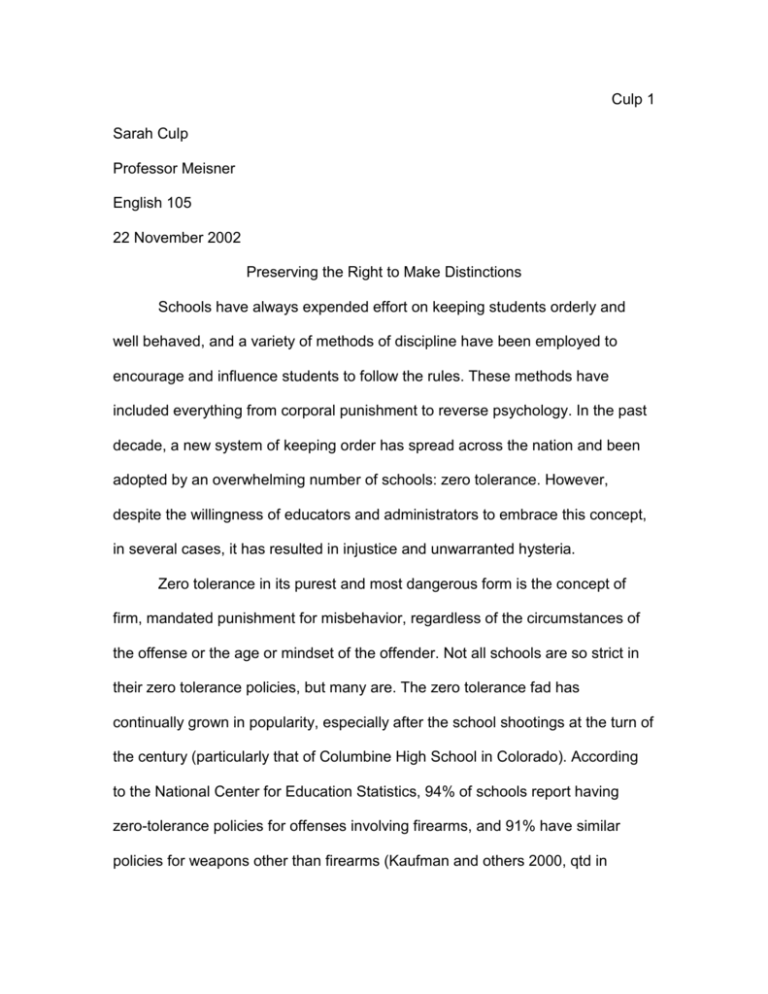ztdraft - Nerdland User Pages
advertisement

Culp 1 Sarah Culp Professor Meisner English 105 22 November 2002 Preserving the Right to Make Distinctions Schools have always expended effort on keeping students orderly and well behaved, and a variety of methods of discipline have been employed to encourage and influence students to follow the rules. These methods have included everything from corporal punishment to reverse psychology. In the past decade, a new system of keeping order has spread across the nation and been adopted by an overwhelming number of schools: zero tolerance. However, despite the willingness of educators and administrators to embrace this concept, in several cases, it has resulted in injustice and unwarranted hysteria. Zero tolerance in its purest and most dangerous form is the concept of firm, mandated punishment for misbehavior, regardless of the circumstances of the offense or the age or mindset of the offender. Not all schools are so strict in their zero tolerance policies, but many are. The zero tolerance fad has continually grown in popularity, especially after the school shootings at the turn of the century (particularly that of Columbine High School in Colorado). According to the National Center for Education Statistics, 94% of schools report having zero-tolerance policies for offenses involving firearms, and 91% have similar policies for weapons other than firearms (Kaufman and others 2000, qtd in Culp 2 McAndrews). Eighty-seven percent of schools have zero-tolerance policies for alcohol, and 88% have policies for drugs. 79% each have policies for violence and tobacco (McAndrews). There are many cases where a student may deserve a reprimand, but, under a policy of zero tolerance, is treated far more harshly than they deserve. For example, in a widely publicized case in 2001, an eight-year-old named Billy Barnes was suspended from his Lockeport, N.S. school after pointing a chicken strip at another student and saying "Bang." In the same year, another eight-yearold was suspended in Jonesboro, Arkansas (which had suffered a school shooting three years prior) after he pointed a chicken nugget at a student and said, "Pow, pow" (Cosh). Children should be taught that guns can be dangerous, and many parents would disapprove of their child simulating a gun (with poultry or any other object). However, for a school to suspend a child, marring their records for the remainder of their academic life, simply for a thoughtless game, is excessive and ridiculous. Simulated weaponry is only one of the areas where schools should allow some leeway to children before jumping to severe punishment. In 1997, a tenyear-old girl in Thornton, Colorado, was threatened for suspension for sexual harassment. The cause was a male classmate's complaint that the girl and her friends had repeatedly approached him on the playground to ask if he liked her, despite his asking them to stop. After an investigation, officials did not attempt to Culp 3 suspend her, but she missed a field trip with her class and, according to her mother, gained a new awareness of the world grown-ups live in. "They jumped to conclusions," she said. "Sorry doesn't mean much to a 10-year-old" (Cummins). The administration of the school had an obligation to the male student to investigate his complaint, and to discipline the girl if warranted. However, there was no reason to incorporate the phrase "sexual harassment" into the proceedings, especially before the case had been fully examined. Had the zerotolerance policy not been in effect, perhaps the officials would have felt less pressure to label the incident and punish the offender. Occasionally, the administration is so eager to ferret out wrongdoing that they end up disciplining those who did nothing wrong at all. Such was the case with 6-year-old Seamus Morris of Colorado Springs. Morris was suspended for half a day for sharing some candy with his classmates – organic lemon drops which neither the principal nor the teacher recognized, and thus treated as a “controlled substance.” As a result, Morris was suspended and, according to his mother, told that he was “lucky to get away with a Level 2 infraction, that it could have been a Level 4 infraction,” which could have resulted in a year’s expulsion. The paramedics were also notified, and one student was taken to the hospital, despite displaying no adverse reaction (Foster 5A). In other situations, zero tolerance has forced punishment for students who, while technically breaking the rules, had mitigating circumstances that should have been taken into account before a penalty was decided. The most Culp 4 extreme example of this is the case of Brett Ratner, an eighth-grader in Purcellville, Virginia. Ratner discovered that one of his classmates was considering suicide. When she showed him the knife she had with her, Ratner took the knife and put it into his locker, intending to take it home and discuss the situation with his mother, a nurse. The school’s dean discovered the knife, and the school board voted to suspend Ratner for four months for having a weapon on school grounds. Ratner unsuccessfully appealed the decision and then sued the district for violation of his rights to due process and freedom from cruel or unusual punishment, but the U.S. District Court for the Eastern District of Virginia rejected his case (“Supreme Court” 1). There are dozens of other reported cases of punishment under zero tolerance policies wherein the offender has exhibited no malice or intent to cause disorder. An eighteen-year-old girl in Naples, Florida was arrested one week before graduation, after a school resource officer discovered a knife on the floor of her parked vehicle. Despite her explanation that she had been helping a friend move the previous weekend and the knife had been left behind, she was arrested. The charges were later dropped, but she missed her graduation ceremony. In other cases, children were suspended for offenses such as drawing a picture of a soldier bearing weapons; wearing a firefighter’s costume to school for Halloween that included a plastic axe; possessing unlit sparklers inside a book bag; and bringing toenail clippers to class (Cosh). All of these cases have plausible and benign explanations, which do not warrant such gross punishment. Culp 5 While these examples show the failing of zero tolerance to adequately mete out justice in all cases, the basis of these policies is rooted in the sincere desire to improve schools by controlling the disorder and misbehavior within them. It is proven that academic achievement is linked to the level of order and discipline in the school environment (Barton, Coley and Wenglinsky, 1998, qtd in Holloway). Holding students and their parents accountable for their actions is a noble idea. However, when the students are not old enough to be accountable, or their actions were simple mistakes or oversights with no malicious intent or harmful result, zero tolerance does nothing to improve their character or their environment. A school is not improved by punishing the people who never wanted or attempted to ruin it, and that is what happens when administrators put aside their own judgment in favor of the blind mandate of zero tolerance. The solution is to inject human perspective back into the disciplinary process. There is nothing wrong with having strict guidelines in a school, or with severe punishments for people who knowingly break rules and/or endanger other students. However, administrators should be given the freedom to make rational decisions regarding who deserves expulsion, suspension, detention, a reprimand, or a warning. According to Todd Gaziano, director of the legal center for the Heritage Foundation (a conservative group), Discipline requires judgment calls…Part of the job of educators is to make distinctions between a little bit bad and something really threatening. Parents are ashamed that school officials can't Culp 6 exercise common sense. We entrust them with our children. If they can't distinguish between a chicken finger and a gun, or a prank which deserves a reprimand and a real crisis, then how can we trust them to teach proper moral behavior? (Schuster) We cannot expect our nation’s educators to serve simply as walking, talking lists of rules and regulations. Many parents decry the lack of personal attention their children are given in schools, with large class sizes and principals who stay in their offices. How can those things be remedied when we have policies restricting our students from being seen as distinct human beings when they are disciplined? As the zero tolerance fad grows, our schools become more militaristic and less humane. It is essential that we examine the failings of these policies while we are still able to amend or reverse them.







